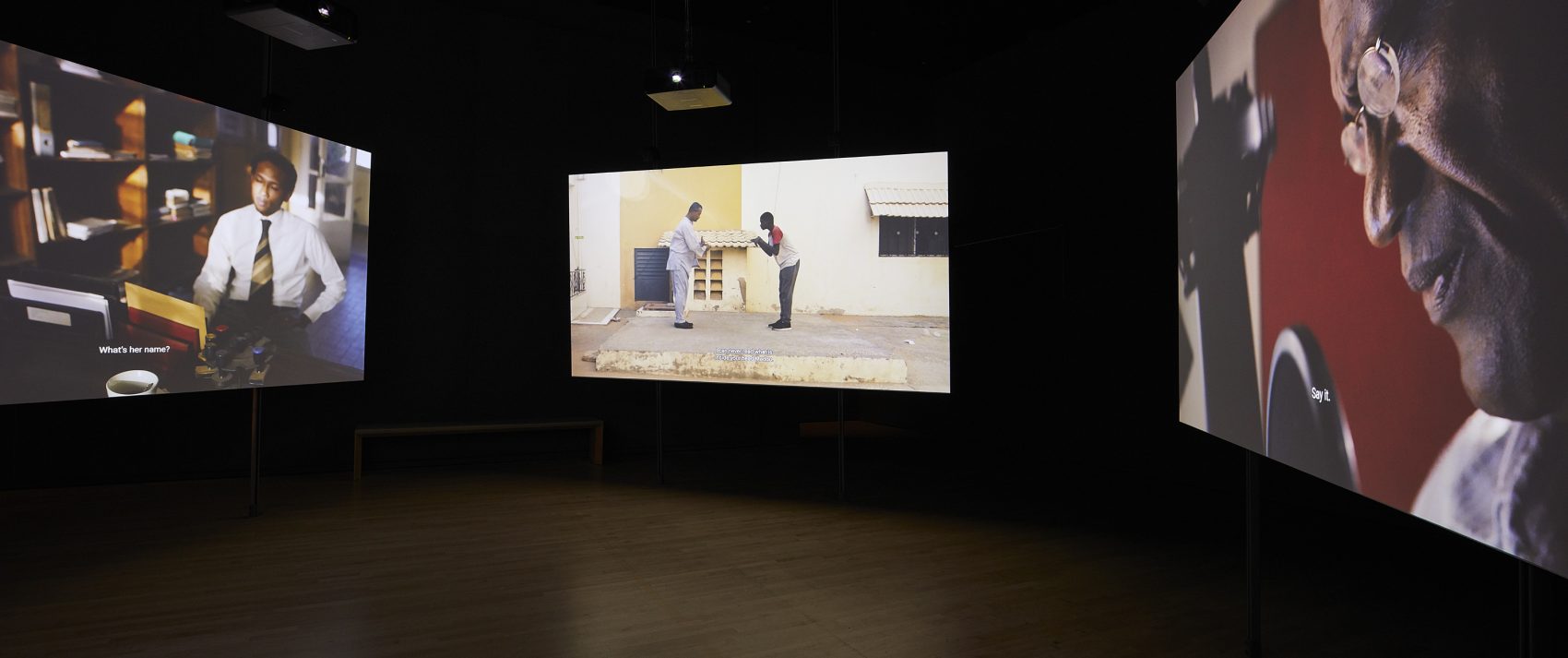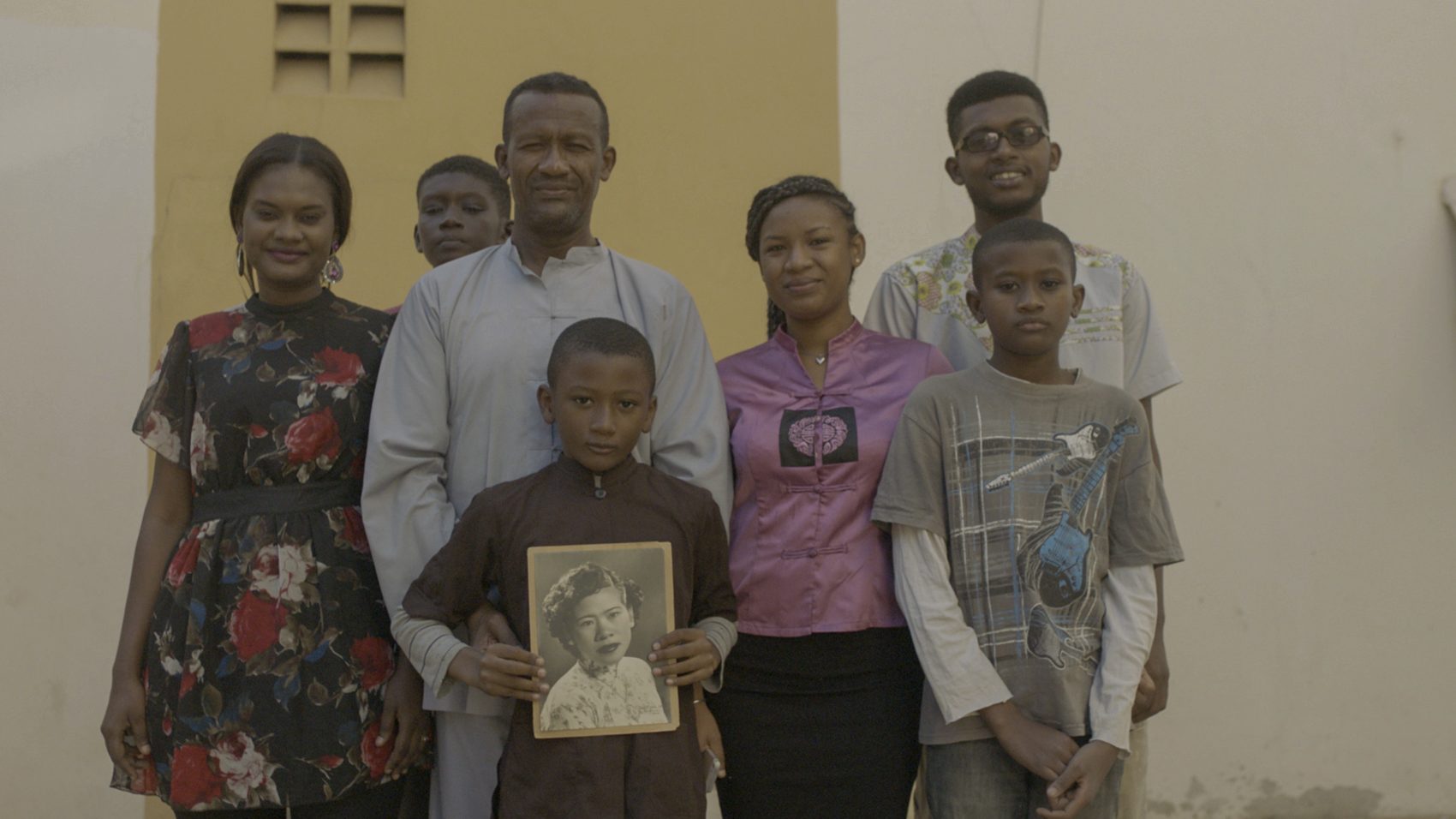The Dash column explores art and its social contexts. The dash separates and the dash joins, it pauses and it moves along. The dash is where the viewer comes to terms with what they’ve seen. Here, Harley Wong dwells with the memory of Tuan Andrew Nguyen’s video installation The Specter of Ancestors Becoming, commissioned for the 2019 Sharjah Biennial and on view in 2020 in Soft Power at SFMOMA from October 26, 2019–February 17, 2020.

Tuan Andrew Nguyen, The Specter of Ancestors Becoming, 2019. Video still. 4-channel HD video with color and 7.1 surround sound, 28 min. Produced by the Sharjah Art Foundation with additional production support from the San Francisco Museum of Modern Art. Courtesy of the artist and James Cohan.
On one of the four towering screens that make up The Specter of Ancestors Becoming (2019) by Tuan Andrew Nguyen, a dark-skinned man named Macodou reads a letter addressed to his father from his birth mother. Written, as he describes, “in very bad French,” the letter is dated 1956, eight days before Macodou’s birth and nearly three months after his father left Sài Gòn. The other three screens largely remain dark; fragments from the past fade in and out, including old photographs and details of the letter’s yellowed paper, like his mother’s signature in elegant cursive: Nguyễn Thi Châu. The letter is filled with love, longing, and heartbreak as she confesses that Macodou’s father left a lasting yet difficult memory. She hopes that, through their child, he never forgets her.
Written and filmed in collaboration with the Vietnamese-Senegalese communities in Dakar and Malika, The Specter of Ancestors Becoming poignantly illustrates the multilayered pride and heartache of being part of the Asian diaspora. The film focuses on the lives of three families spanning decades and continents but sharing a trauma that is simultaneously racial and colonial. Weaving archival footage from the French occupation of Vietnam with present-day images of the Vietnamese-Senegalese community, the installation presents a fractured narrative that forces the viewer to experience some of the difficulties in obtaining and retaining cultural and intergenerational knowledge that many diasporic communities face.

Tuan Andrew Nguyen, The Specter of Ancestors Becoming, 2019. 4-channel HD video with color and 7.1 surround sound, 28 min. Installation view, Soft Power, SFMOMA, San Francisco, October 26, 2019–February 17, 2020. Produced by the Sharjah Art Foundation with additional production support from the San Francisco Museum of Modern Art. Courtesy of the artist and James Cohan, New York. Photo: Johnna Arnold.
In Freud’s conception of melancholia, he defines it as mourning without end; the melancholic cannot overcome their loss in order to invest in new objects. Building on Anne Anlin Cheng’s work on the Asian diaspora, as well as Freud, literary critic David Eng and psychotherapist Shinhee Han have coined the term “racial melancholia” to describe the unresolved feelings of loss and un-belonging that arise from an inability to assimilate into the dominant culture. In the course of collaborating on The Specter of Ancestors Becoming, Macodou shares with Nguyen that he grew up unaware of his Vietnamese ancestry, a decision his father made in the hope of easing his assimilation into Senegalese society. However, Macodou’s Vietnamese “features attracted the taunts and curiosities of [his] classmates,” and made complete assimilation unfeasible. When he discovered the old letter from his birth mother, he could never bring himself to confront his father while he was still alive. What’s left in the wake of loss is melancholy. As Freud articulates, the melancholic “knows whom he has lost but not what he has lost in him.” Macodou is not only deprived of his mother, but also generations’ worth of ancestral knowledge. An inconceivable absence is inherited instead.
To imagine the stories and relationships that have slipped away, Nguyen and his collaborators mix familial history with fiction. In The Specter of Ancestors Becoming, Macodou imagines a confrontation with his father through the character of Madou, a stand-in for his thirty-year-old self, and expresses his sense of betrayal about the erasure of his Vietnamese ancestry. Although we don’t get to witness the events and conversations that led to Macodou’s father leaving Sài Gòn, we meet a different couple—Lan and Waly—similarly deciding their fates. Written by Anne-Marie Niane and based on her parents, the pair trade painful truths and difficult questions with increasing urgency. Even though Niane remembers her mother as pensive and silent on most matters, she gives Lan the agency to voice her opposition to Waly’s intentions to relocate their family of five from Sài Gòn to Dakar. “Can you promise me that one day we’ll return?” asks Lan. But a resolution is never reached. For the final chapter of Nguyen’s trilogy, collaborator Merry Bèye Diouf remembers combing her grandmother’s hair after lunch. While her grandmother would only occasionally share stories of Vietnam, Diouf amplifies this exchange, collapsing time and perspectives to show the transference of lifetimes of memories in mere minutes. Nguyen and his collaborators imagine a potential history—to borrow a term from theorist Ariella Aïsha Azoulay— that actively embraces Vietnamese culture and encourages open intergenerational conversations about personal racial trauma.

Tuan Andrew Nguyen, The Specter of Ancestors Becoming, 2019. Video still. 4-channel HD video with color and 7.1 surround sound, 28 min. Produced by the Sharjah Art Foundation with additional production support from the San Francisco Museum of Modern Art. Courtesy of the artist and James Cohan.
Fixating on the retrieval and preservation of cultural traditions, unlike attempts to assimilate, can ultimately ground one’s suspended identity. To honor his birth mother, Madou names his daughter after her. By giving his Senegalese daughter a Vietnamese name, Madou rejects the social pressures to assimilate to which his father succumbed. At the same time, on a separate screen, we see Macodou practicing kung fu drills with his real-life son in a gesture of ritual healing. By transferring traditions and actively participating in his family’s Vietnamese culture, Ma(co)dou works to prevent the transmission of intergenerational trauma. Daily rituals to facilitate memory continue into the final chapter of Nguyen’s trilogy. Fatima and Maam, inspired by Diouf’s relationship with her grandmother, rigorously exchange stories of Vietnam. During a crucial moment in Dakar’s Vietnamese-Senegalese community when the last monoracial Vietnamese women are passing away from old age, we witness Fatima rehearsing to inherit her grandmother’s voice and memories.
Nguyen and his collaborators articulate that the racial melancholia that permeates their lives does not stem from an inability to assimilate, as Eng and Han would suggest, but from the slipperiness of Asian diasporic memory. The multiple storylines in The Specter of Ancestors Becoming and the installation’s configuration intentionally disorient the audience. Each additional viewing produces a new revelation and is needed to fully process and appreciate the intricacies of Nguyen’s film. This act of repetition on the viewer’s part parallels the oral tradition of storytelling and the characters’ personal processes to feel connected to their Vietnamese ancestors. To be a part of the Asian diaspora is to slowly forget, and remembering is a conscious act that must be performed continuously and diligently without a foreseeable end. A vital diasporic community is created from this unavoidable feeling of loss. x

Harley Wong is an arts writer and critic based in New York.